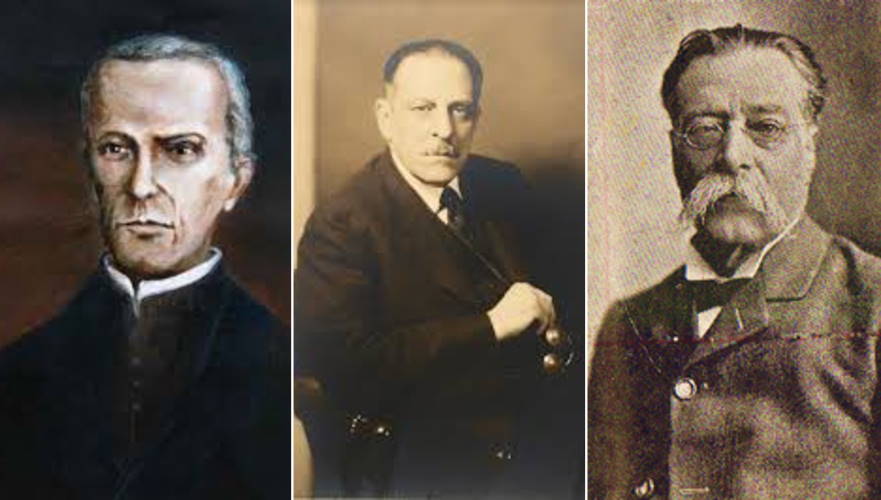HARRISONBURG, United States. — This Sunday, August 28, three significant events coincide in Cuban national history: the 260th anniversary of the birth of José Agustín Caballero, the 150th anniversary of the birth of Manuel Márquez Sterling and the centenary of the death of Emilio Bacardí Moreau, three extraordinary Cubans.
José Agustín Caballero: A priest who cracked the mold
He entered the Seminary of San Carlos and San Ambrosio at the age of twelve on the same day of its foundation, April 4, 1774. He then continued studying at the San Gerónimo school in Havana, where he obtained a bachelor’s degree in Arts in 1771. , Bachelor of Sacred Theology in 1787 and Doctor of Sacred Theology in 1788. He began as a priest in 1781.
When analyzing history, it is striking how apparently trivial events are woven together over the years to weave others of importance. I make this statement because the call to banish the rigidity of scholastic thought has its roots precisely in José Agustín Caballero, of whom Félix Varela was a student, as were José Antonio Saco and José de la Luz y Caballero, who had a profound influence on José Marti.
Jorge Castellanos rightly wrote about these invisible —or dismissed— ties in his work Roots of the Bourgeois Ideology in Cuba: “Traditional Cuban historiography has not wanted to take into account the merits of all those men who humbly and quietly prepared the ground for the profound renewal of philosophical, educational and civic values that Cuba experienced in the first third of the 19th century. Until now Varela -the hero- has monopolized all the laurels. The rest – the precursors – have been systematically forgotten”.
One of those precursors was José Agustín Caballero, a thinker and writer closely linked to the movement known as the Creole Reformist Enlightenment, which emerged at the end of the 18th century and lasted well into the 19th century. This movement is credited with the beginning of the Cuban cultural and ideological transformation, which would have in Varela and Martí other essential references in that century.
Manuel Márquez Sterling, president for six hours
Although he is recognized as an iconic figure of Cuban journalism during the Republican era, Márquez Sterling was also a diplomat, politician, writer and chess player.
He started as a journalist in The village Y The Camagüeyan in 1889, when he was sixteen.
In 1895 he met José Martí and declared himself a supporter of Cuban independence, for which he had to go into exile, settling first in Mexico and then in the United States.
He returned to Cuba when the intervening US government was still on home soil. From then on, he assiduously practiced journalism, being also the founder of the newspapers The world (1901), The herald of Cuba (1913) and The nation (1916).
Occupying the position of Cuban ambassador in Mexico, he stood out for the protection he granted to Francisco Madero and other of his followers when the coup against the Mexican president took place. His reflections on the event were exposed in his book Madero’s last days.
Márquez Sterling wrote about fifteen books, among which are some dedicated to the game of chess, one of his passions.
He radically opposed the dictatorship of Gerardo Machado. When President Carlos Hevia had to resign due to pressure from Fulgencio Batista, a power vacuum was created. To cover it up, Márquez Sterling, who was Secretary of State, assumed the presidency of the country from six in the morning until twelve at noon, when the position was assumed by Carlos Mendieta. This event made Sterling one of the most fleeting presidents in world history.
He was a tenacious critic of the Platt Amendment. On May 29, 1934, when he held the position of Cuban ambassador in Washington and after having signed the treaty that repealed the infamous text, he declared: “Now I can die in peace.”
Emilio Bacardí Moreau: a lie to Castro’s propaganda
He was born in Santiago de Cuba on June 5, 1844 and was the son of Facundo Bacardí and Massó, the Catalan founder of the important rum company that bears that last name.
He moved to Barcelona when he was very young and there he did his primary studies and some painting.
He stood out early in literature by obtaining in 1867 a prize awarded by the Port-au-Prince Lyceum.
Due to his links to the Cuban independence movement, he was sent in 1876 to the Spanish prison of Chafarinas. Finished the Ten Years War He returned to Cuba, but because he was linked to the conspiracy that was forging the uprising later known as the Little War, he was deported again to Spain in 1879.
A year after the third war for our independence began, Emilio Bacardí suffered his third exile accompanied by prison, this time in Ceuta.
Obtained independence and settled again in Santiago de Cuba, he was elected mayor in 1901.
As a ruler, he carried out an active work that has transcended to this day as an example of civility, which denies the reiterated Castroist affirmation that all the politicians of the republic were corrupt.
In the case of Emilio Bacardí, as a result of his work for the benefit of his hometown, the creation of the museum that bears his name can be cited, where valuable documents and objects related to our wars for independence are exhibited. Attached to the museum is still the Elvira Cape Library, also founded by him. To these works was added the Academy of Fine Arts, all created largely with funds from Bacardi’s personal fortune.
Retired from politics, Bacardi devoted himself entirely to literary creation. Among his most outstanding works are the Chronicles of Santiago de Cubawritten in ten volumes, the chronicles of his travels through Egypt and Palestine and the drama the abyss, staged in 1912 by the company of Virginia Fábregas. But scholars agree in pointing to his novels Way of the Cross Y Dona Giomar as the most transcendent of his literary creation, although much of it was left unpublished when he died a day like today a hundred years ago.
OPINION ARTICLE
The opinions expressed in this article are the sole responsibility of the issuer and do not necessarily represent the opinion of CubaNet.
Receive information from CubaNet on your cell phone through WhatsApp. Send us a message with the word “CUBA” on the phone +1 (786) 316-2072, You can also subscribe to our electronic newsletter by giving click here.
















